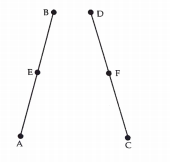In the fig. AE=DF where E and F are mid-points of AB and DC respectively.Using Euclid's axiom, prove that AB=DC
 Solution in Punjabi
Solution in Punjabi
Step by step video & image solution for In the fig. AE=DF where E and F are mid-points of AB and DC respectively.Using Euclid's axiom, prove that AB=DC by Maths experts to help you in doubts & scoring excellent marks in Class 9 exams.
Topper's Solved these Questions
- BOOK - MODERN PUBLICATIONCHAPTER - INTRODUCTION TO EUCLID'S GEOMETRYEXERCISE - EXERCISE86videos
INTRODUCTION TO EUCLID'S GEOMETRY
- BOOK - MODERN PUBLICATIONCHAPTER - HERON'S FORMULAEXERCISE - EXERCISE69videos
HERON'S FORMULA
- BOOK - MODERN PUBLICATIONCHAPTER - LINEAR EQUATIONS IN TWO VARIABLESEXERCISE - EXERCISE151videos
LINEAR EQUATIONS IN TWO VARIABLES
Similar Questions
Explain the difference between an axiom and a theorem.
06:07View SolutionFind the area of the triangle, the lengths of whose sides are 18 cm, 24 cm and 30 cm.
02:11View SolutionCheck whether of the following are solutions of the equaions 2x-y=8 and which are not:
(0,8)01:31View SolutionWhich of the following are correct chain isomers of butane ? (i)
02:46View SolutionDetermine the point of symmetry of a regular hexagon.
02:45View SolutionDtermine the images of the following figure about the given line :
02:17View SolutionIn the figure above (not to scale), ¯¯¯¯¯¯AB⊥¯¯¯¯¯¯CDandAD is the bisector of ∠BAE.AB=3cm and AC=5cm. Find CD.
05:41View SolutionMatch the following Column A to Column B
 02:10View Solution
02:10View SolutionMatch the following Column A to Column B
 02:17View Solution
02:17View SolutionMatch the following Column A to Column B
 02:10View Solution
02:10View SolutionThe inequation represented by the graph given below is :
04:23View SolutionThe inequation that best describes the graph given below is _________
01:13View SolutionThe inequation that best describes the following graph is _________
01:49View SolutionWhich inequations represent the shaded region in the given figure
03:10View SolutionIn Fig, find the value of x.
ltimg src="https://d10lpgp6xz60nq.cloudfront.net/physics_images/PS_MATH_IX_C12_S01_032_Q01.png" width="80%"gt01:44View SolutionAt point P, the value of (dy)/(dx) is : ltimg src="https://d10lpgp6xz60nq.cloudfront.net/physics_images/ALN_PHY_R04_E01_025_Q01.png" width="80%"gt
01:54View Solution

